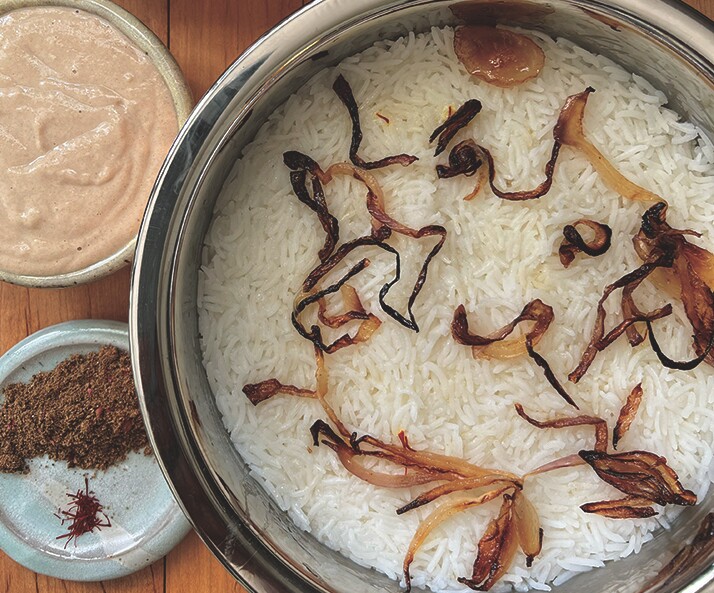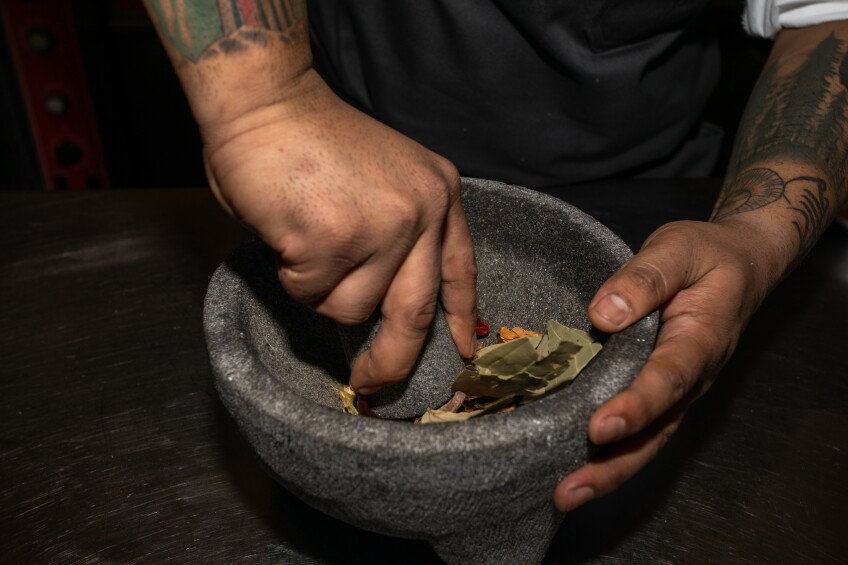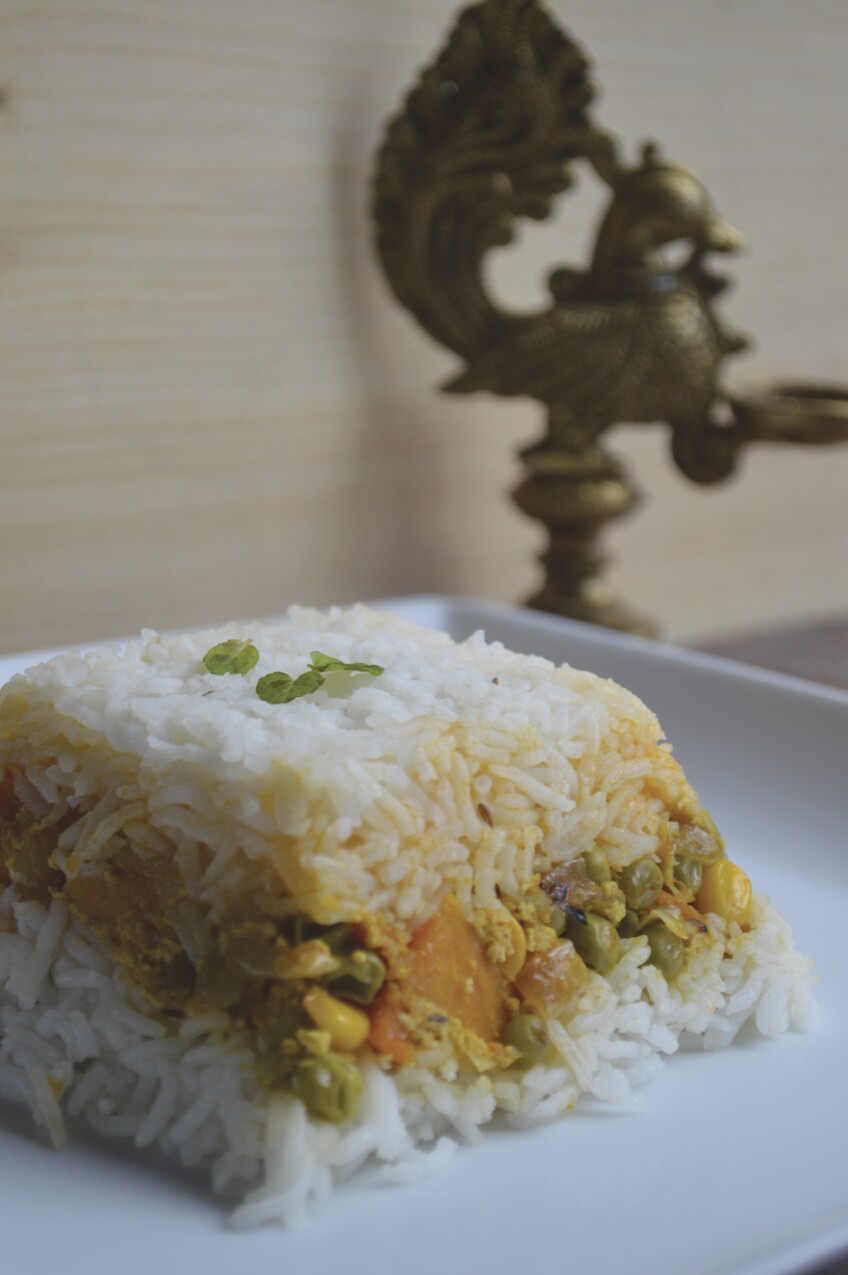The Complexity and Regionality of India's Biryani in Southern California

"Eid Mubarak Bhabi! Biryani bhij-wa raha hoon, aaj khana mat banana." (Blessings for Eid, sister-in-law. I am sending Biryani, don't cook today). Chacha (paternal uncle) unfailingly called to wish us each Eid while he was alive, with his big-hearted gift of blessings and biryani. We are not Muslim or even related to him, but his decades-old friendship with my father deemed we address him affectionately as "Chacha." He never asked if we wanted the biryani or how much. A large cauldron still warm from the coal stove holding a succulent biryani, one that had been slow-cooking for hours in the community kitchen would travel from one side of Mumbai to another and arrive at our doorstep before the noon hour. It would take two strong young people to carry the aluminum pot, the handi, four flights of stairs up to our apartment, holding enough chicken (or goat) biryani to feed the neighborhood. Another large cauldron contained similar portions of fried chicken and third, a light, runny yogurt raita to balance out the heat accompanied the first cauldron. He sent it in the spirit of celebration, and we shared it with neighbors in the same spirit, because if we didn't, we would be eating biryani for weeks.
Indians need no excuse to make, share and wax poetic about biryani. Biryani is the ultimate culinary exercise, and a perfect biryani expertly balances flavors and techniques with texture and aroma. This is a layered one-pot dish mainly of rice and protein. In it, every ingredient has a specific role in developing the flavors. Here, after slow cooking for several hours, robust spices mellow into delicate aromas. Every region makes biryani in its own special way. Using locally-preferred ingredients, unique flavors shine in the most nuanced but deliberate ways. A biryani cooked for hours like the one from Chacha's community kitchens is the kind that a food lover dreams about. And like the biryani itself, its story, origins and ingredients are made up of many layers.
India's Regional Biryanis

India's many regional cuisines, including the many varieties of biryanis, carry the geopolitical influences of both the Mughal Empire (1526-1707) and the British (1700-1947). Most Indian food historians agree that biryani came to India thanks to Persian and Mughal influences while India was still a collection of several smaller kingdoms. This large Indian subcontinent included present-day Pakistan and Bangladesh. When Mughal kingdoms grew and spread across the land, they each developed their own culinary styles. The overlay of the Mughal rule on local Hindu kingdoms created cuisines like the Kashmiri and Awadhi cuisine in north and north-central India, the Hyderabadi and Nizami cuisines of the Deccan plateau in south-central India. The Persian Empire also influenced India's western and northwestern cuisines.
After the Mughals, British rule united all these kingdoms under a single banner for governance, but the culinary styles of different regions remained. However, after India's independence from the British in 1947 it was partitioned into two: India and two Pakistans: West Pakistan (present-day Pakistan) and East Pakistan (present-day Bangladesh). Shortly after, in 1971, Bangladesh further separated from Pakistan in a bloody war. From the trauma of the migrations came border cuisines that celebrated all that once was. Because of the complicated histories of the Indian continent, it is not unusual to find Bengali cuisine influenced by Bangladesh or Pakistani influences on Western Punjab and Western Rajasthan cuisine.
While I was too young to dissect the intricate flavors of Chacha's biryani or pinpoint regional nuances, the last few decades of being an Indian expat have allowed me to explore regional expressions more closely. One is never short of fellow Indian expats who enthusiastically share their nostalgia for home-cooked meals through biryani. Hailing from a country like India, where any recipe is interpreted differently, any talk of biryani quickly elicits comparisons, spirited debates marking the nuanced differences, and subsequent potlucks to determine who makes the best biryani. These food stories bring us together and create deeper friendships and familial bonds where none existed.

It Starts With the Pot
Although I affectionately address her as Neela Masi (Masi = maternal aunt), Neela Paniz is a Southern California-based cookbook author and restaurateur whose Santa Monica restaurant Bombay Café is still talked about long after it closed. Paniz has likely cooked thousands of biryanis in her life, and her biryani stories span decades. Over a lunch visit one spring afternoon, instead of cooking or eating biryani together, we do something far less labor-intensive and infinitely more enjoyable: pour over her handwritten biryani recipe from when she first learned to cook it. Her recipe included tomatoes, resulting in what is now known as Ambur biryani. She fondly reminisced about using a traditional biryani handi, a wide-mouthed tin-glazed copper utensil, watching the amount of water she used, and of course, the many kinds of utensils she has experimented with. The shape of a traditional handi ensures that the condensation trickles down slowly back into the pot from the sides for tender meat. When she included a Hyderabadi biryani demonstration at a luxury hotel while leading a culinary tour in India, she noted that classically trained chefs incorporated traditional techniques like ensuring the 'dum' process, because it is the one step that separates it from being a pulao, a one-pot dish tossed with seasoned vegetables or meat. "Dum" cooking is where the dish is cooked in a heavy bottom container sealed shut with a dough paste for the final cooking. She added, "I watched [the chefs at the luxury hotel], mentally checking against what I had learned all those years ago from our family chef, and no surprise, I had been following the same techniques. But by golly, the dum seal is impossible to remove!" When she returned from India, she found a different utensil to simplify the clean-up of the dough paste: a large Dutch-oven pot with a separate silicone seal. It seals her biryani just like doing a 'dum,' without needing additional cleanup. Neela Masi advised, "A good pot is the first and most important step in building a good biryani."

Although the dum process is the final step before a biryani is ready, it preserves the flavors and aromas of every ingredient that goes into the biryani. Every region uses a different combination of methods and ingredients. These preferences vary in the proteins and additions, the treatment of meat and meat-broth or yakni, the selection of whole spices and fresh spices, right down to the rice and the final aromatics. With so many combinations, it is no wonder that there are more than a handful of biryani varieties.

Biryani is typically a meat-based dish. The meat for the biryani is bone-in, as the marrow adds an additional layer of flavor. The meat is marinated in a paste of fresh and dried spices, preferably overnight. Sometimes the meat is marinated in yogurt as in Awadhi biryani and Hyderbadi biryani. In some regions, the marinated meat is precooked in water before it is added underneath the rice layer for a pukka method of making biryani. The resulting broth or yakni is sometimes converted into a separate 'salan,' served alongside the finished biryani as au jus. In other regions, the marinated but raw meat is layered underneath the rice. This method is also known as the kuccha method. In the Thalessery region or Tellicherry region along the southwestern coast of India, the meat is cooked in coconut milk, to create a Thalessery Biryani. Thalessery is a coastal town, and was never under Mughal rule. However, the frequent traffic of visiting Arab spice traders in the pre-Independence era, and more recent emigration of migrant workers from Kerala to middle eastern countries has influenced the local coconut-heavy cuisine, as seen in the Thalessary Biryani.
Three neighboring regions of the upper north and northeast: Awadh/Lucknow, Bengal and Bangladesh reflect the most geopolitical influences, mergers and identities like none other.

In most Awadhi biryani recipes, the meat is marinated in yogurt and spices for a delicate preparation. Restaurant versions of Awadhi biryanis use a spice blend 'Lazzat-e-taam', a nuanced assemblage of more than 30 spices when making the yakni or converting it into salan. If it is a kuccha method, 'Lazzat-e-taam' is sprinkled directly into the preparation.
Meanwhile, for a Bengali biryani the meat may or may not be marinated in yogurt, but it is first cooked in water and spices. My Bengali friend Debashri Sengupta, who has family roots in Bangladesh, and who grew up partially in Hyderabad makes a Bangladeshi biryani for her family with some Bengali flair. She seasons the water with spices like fennel, cardamom and black pepper. But that is not all.
The Bengali biryani includes potatoes courtesy of Wajid Ali Shah, the 10th Nawab of Oudh (Awadh/Lucknow). When the Shah relocated to present-day Kolkatta in 1856, he brought his Awadhi biryani with him, but being short on funds, inspired the addition of potatoes to the biryani. Potatoes came to India via the Portuguese. These were not only a novel addition to the biryani, they were also easier on the pocket than the meat, took on the flavors easily and added the desired volume to the finished dish. In Hyderabad, boiled eggs are often added to the layering process for added protein.
Every regional biryani elicits different memories for different people based on where their favorite biryani comes from.Nandita Godbole
Dried spice blends are the most intriguing and unique markers of regional biryanis. Just as Lazzat-e-Taam is linked to the Awadhi biryani, every regional biryani elicits different memories for different people based on where their favorite biryani comes from. Chef Sanjay Rawat, chef de cuisine at Ritz Carlton, Laguna Niguel, grew up around a mosque in New Delhi. He recalls that each Friday, a biryani stall would pop-up to serve goat or chicken biryani to the faithful and the food enthusiasts alike. It was made with robust spices like black cardamom and Indian bay leaf. "I would rush out to the mosque just as the call to prayer ended, and wait to pick up and then devour the biryani!", he recalls. As a chef, biryani memories start at the one he ate as a child, favoring classic regional spices blends. To this day, Rawat frequently caters to the Indian wedding clientele at the Ritz Carlton. He will favor traditional regional biryani ingredients, like a combination of the traditional cockscomb flower extract, Kashmiri saffron and Kashmiri red chilies to make a Kashmiri biryani, or creating the right balance of aromatics when creating special biryani requests for Indian wedding clients. Regardless of the biryani he makes, unfailingly, Rawat adds the dum as a finishing touch.

Sometimes, it only takes one spice to mark a regional biryani. Masala Bae, in Irvine, California serves a Sindhi biryani, from India's northern neighbor, Pakistan. This Sindhi biryani includes a dried prune in place of the traditional sour plum for a delicate layer of unexpected, sweet-and-sour tanginess in the rice. Meanwhile, a layer of fresh mint is more common in biryanis from Hyderabad and Southern India, along with a heaping serving of caramelized onions, for the aroma known as 'birista' before the dum process. Fresh local produce like fiery hot local chiles and fresh curry leaves are often a part of Vijayawada biryani. While a finishing sprinkle of Kewra (screw pine or Pandanus) water is favored in western India, the Awadhi biryani and Bengali biryani use both Kewra and rose water.

Seafood biryanis are less common. However, Murshidabad, a town upriver from Kolkatta on the banks of the Hoogly River is known for its fish biryani, one that uses marinated and fried fish in the preparation.
Many scoff at the idea of a vegetarian biryani, sometimes called 'Tehari' Biryani. This name plays off the word for a Hindu religious holiday, a tewahar. Most Hindus observe vegetarianism over religious holidays. A large population of India is strictly vegetarian, like San Francisco-based author Rasana Atreya and Atlanta-based author Anju Gattani. While Atreya grew up in India, Gattani grew up in Hong Kong and had to learn many traditional Indian dishes through experimentation after she was married. Gattani's biryani experiments came about to appease her husband's craving for a Hyderabadi biryani. "I had never eaten a biryani in my life, before he asked for it!" she exclaims. Gattani and Atreya simply swap out the meat for a blend of vegetables like carrots, green beans, potatoes and sometimes paneer — and proceed with the biryani recipe. They both prefer the Hyderabadi technique of adding fresh mint leaves to the rice before the biryani is sealed for dum. To replace the brothy meat-based salan, Gattani sets aside a small amount of her spice paste before she adds her vegetables, to which she then adds a generous number of green chilies. This salan makes a heat-laden side dish in case the biryani itself isn't spicy enough.

The quality and texture of the rice makes all the difference too! To account for the dum, the layered biryani must have just the right amount of liquid so that the layering of the meat and rice are not lost into a soup or a risotto-like mush. Chefs will typically use par-cooked rice in the layering process so the rice grains are left fluffy, tender and aromatic. Neela Masi even showed me how she eye-balls the water based on the quantity of meat!
A layered biryani is time-consuming and often reserved for special occasions and large gatherings like important religious holidays, weddings and community events. The different ingredients — meat, basmati rice, and special spices can make for an expensive dish. This dilemma has made way for a one-pot method, suitable for a homestyle preparation — and created dishes like the Thelessary biryani and the Dindigul Thalakapatti biryani from Tamil Nadu in Southern India. In addition to being one-pot dishes, neither use basmati rice. The Dindigul Thalakapatti biryani is made with a blend of fresh herbs like cilantro and mint and whole spices like Indian bay leaf, cardamom, mace, and more. Many Los Angeles based restaurants offer this on the menu, including Podi Dosain Artesia. Sri Sambhagi of Banana Leaf, Los Angeles who includes Dindigul Thalakapatti biryani on his menu explains that this is a pukka method, wherein the rinsed small grain rice is added directly into the pot along with enough water to cook both the meat and the rice in the dum method. They use Seera Samba rice, the grain resembling plump cumin. This small grain rice adds a delicate sweetness as the flavors coat each grain better than the long grain basmati rice. Similarly, the Thalessery biryani uses a short-grained rice called Kaima rice.
The Final Seal of Approval

A good chef will insist on the "dum" process, so the flavors develop during the final cooking. Without the dum, it is a pulao. A vintage biryani recipe by Premila Laal, author of the 1968 "Indian Recipes," includes a double boiler method in addition to the dum, to finish cooking the biryani. In Neela Masi's notes, I learned that Malti Divecha's cookery class instructions for a chicken biryani (c. 1970) included putting coal embers on the lid if the biryani was cooked on a coal stove! However, home cooks replicating the dum method, especially if they are cooking a one-pot dish will rely on the ease of a pressure cooker or use a heavy-bottom cast iron dish.
And while the biryani is cooking, the chef shifts their attention to making a salan, or alternately, a yogurt-based raita, and perhaps a phirni for dessert.
~
Biryani elicits all kinds of warm and comforting memories, and brings people together in the best ways. A heaping serving of a Thalessery biryani or Thelekapatti biryani takes my husband instantly to his aunt's kitchen in Southern India, I will forever remember my afternoon visit with Neela Masi and pouring over her biryani recipes, and every Eid I believe that Chacha is enjoying his biryani in the heavens now along with my father by his side. I may never learn about the nuances of the biryani he sent us. And until I spend more time exploring the finer points of India's many regional biryanis with friends, Chacha's will be the best biryani I will have ever eaten.






